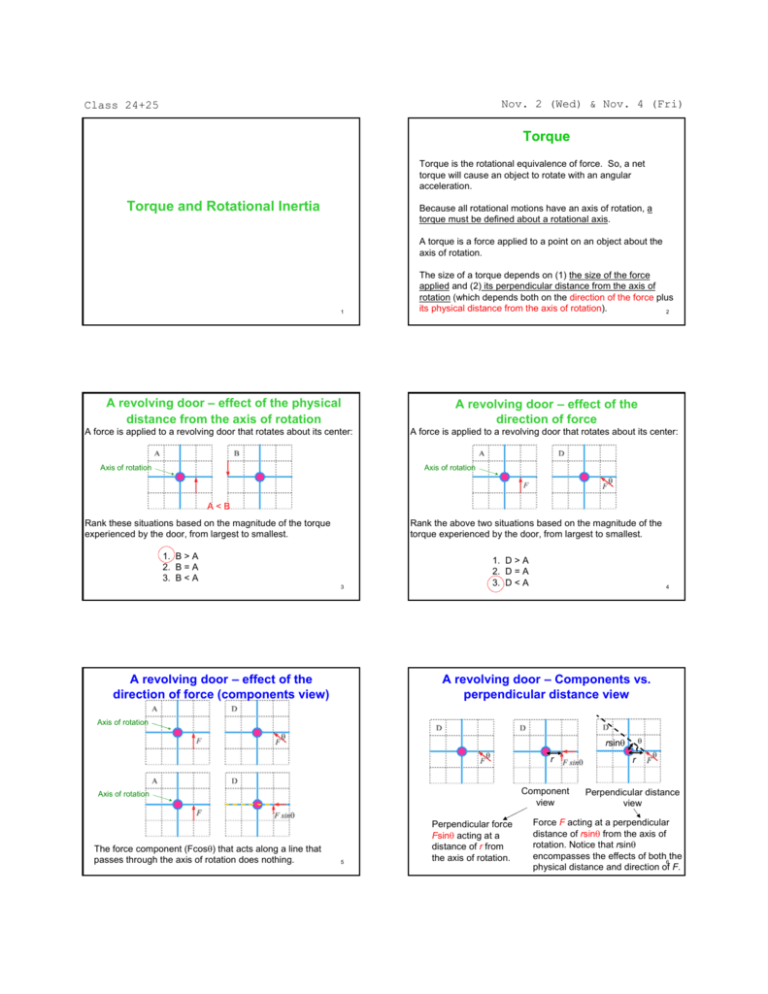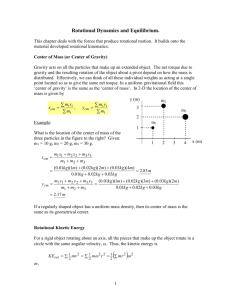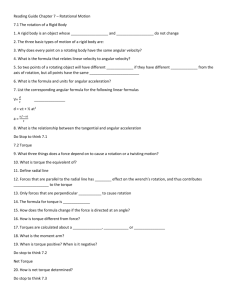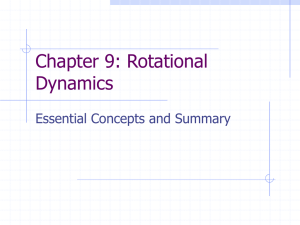Torque and Rotational Inertia Torque
advertisement

Nov. 2 (Wed) & Nov. 4 (Fri) Class 24+25 Torque Torque is the rotational equivalence of force. So, a net torque will cause an object to rotate with an angular acceleration. Torque and Rotational Inertia Because all rotational motions have an axis of rotation, a torque must be defined about a rotational axis. A torque is a force applied to a point on an object about the axis of rotation. 1 A revolving door – effect of the physical distance from the axis of rotation A force is applied to a revolving door that rotates about its center: Axis of rotation The size of a torque depends on (1) the size of the force applied and (2) its perpendicular distance from the axis of rotation (which depends both on the direction of the force plus its physical distance from the axis of rotation). 2 A revolving door – effect of the direction of force A force is applied to a revolving door that rotates about its center: Axis of rotation A<B Rank these situations based on the magnitude of the torque experienced by the door, from largest to smallest. Rank the above two situations based on the magnitude of the torque experienced by the door, from largest to smallest. 1. B > A 2. B = A 3. B < A 3 A revolving door – effect of the direction of force (components view) 1. D > A 2. D = A 3. D < A 4 A revolving door – Components vs. perpendicular distance view Axis of rotation θ rsinθ r Component view Axis of rotation The force component (Fcosθ) that acts along a line that passes through the axis of rotation does nothing. 5 Perpendicular force Fsinθ acting at a distance of r from the axis of rotation. r Perpendicular distance view Force F acting at a perpendicular distance of rsinθ from the axis of rotation. Notice that rsinθ encompasses the effects of both the 6 physical distance and direction of F. Example: Torque on a rod Torque Axis of rotation Find the torque applied by the string on the rod shown below. r In short, torque is a vector with magnitude given by: τ = r F sinθ FT where θ is the angle between r and F. Unit (SI): Nm τstring = LFTsinφ The direction of a torque (counterclockwise or clockwise) is determined by the direction of rotation the torque will cause an object to adopt from rest. Direction: anticlockwise 7 8 Net torque acting on the rod in Example 1 Torque due to the weight of an extended object So, there are actually two torques acting on the rod about the hinge (labeled axis of rotation in the figure), one from the tension in the string, τFT, and one from the rod’s own weight, τmg: For an extended object (i.e., one whose mass is distributed over a volume in space), the torque due to its weight (mg) is that due to a force equal to mg acting downward at its center of mass. τFT = LFTsinφ τmg = −(L/2)mg Center of mass of the rod L/2 (Negative because it produces rotational motion in the opposite direction to τFT.) mg Axis of rotation The net torque acting on the rod is a sum of the two torques: τ = τFT + τmg 10 mg 9 The distribution of the mass of a rod about an axis is more spread out when the axis is located at the edge of the rod than when it is located at the center of mass. Rotational Inertia or Moment of Inertia The rotational equivalence of mass is moment of inertial, I. It accounts for how the mass of an extended object is distributed relative to the axis of rotation. For a point mass m connected to the axis of rotation by a massless rod with length r, I = mr2. Axis of rotation m r If the mass is distributed at different distances from the rotation axis, the moment of inertia can be hard to calculate. The expressions for I for several standard shapes are listed on the next page. A table of rotational inertia ________________ ___________ ______ ______ 11 ________________ ____________ ________ _________ 2 3 12 The parallel axis theorem Newton’s Second Law for Rotation If you know the rotational inertia of an object of mass m when it rotates about an axis that passes through its center of mass, the object’s rotational inertia when it rotates about a parallel axis a distance h away is: I = ICM + mh 2 v v ∑τ = Iα v v is the rotational equivalent of ∑ F = ma. Torque plays the role of force. Take a ring with radius R and mass M as an example: Rotational inertia plays the role of mass. Axis of rotation x The equation, Angular acceleration plays the role of the acceleration. x I = MR2 I = MR2 + MR2 = 2MR2 13 14 Newton’s First Law for Rotation Equilibrium For an object to remain in equilibrium, two conditions must be met. An object at rest tends to remain at rest, and an object that is spinning tends to spin with a constant angular velocity, unless (1) it is acted on by a nonzero net torque or (2) there is a change in the way the object's mass is distributed. v (1) The object must have no net force: ∑ F = 0 v (2) and no net torque: ∑ τ = 0 about any rotational axis. Based on Δω/Δt = α = τnet / I, if either τnet is nonzero or if I is changing with time, ω is changing with time. 15 Hinge Force Example 1: Model of our lower arm A hinge force (a vector), FH, generally exists at the hinge (usually the axis of rotation) of an hinged object at equilibrium This is a model of our lower arm, with the elbow being the hinge. Force from the biseps and triseps The figure below shows the hinge force (decomposed into x and y components) for the hinged rod discussed before. By appropriately using the requirements ΣF = 0 and Στ = 0, we can determine both components of FH. FHy 16 Hinge at our elbow joint L/2 Center of mass (CoM) of the lower arm Weight of the lower arm FHx An equilibrium example mg 17 18 Example 1: Model of our lower arm Example 1: Model of our lower arm Draw a free-body diagram for a horizontal rod that is hinged at one end. The rod is held horizontal by an upward force applied by a spring scale ¼ of the way along the rod. Find the reading on the scale (FS) and the hinge force (FH) in terms of mg, the weight of the rod if the rod is at equilibrium. Let FH be the hinge force, and we decompose it into FH,x and FH,y along the x and y direction, respectively. FH,y FH,x FS L/2 v ∑τ = 0 19 Example 1: Model of our lower arm ΣFy = 0 ⇒ FHy + FS – mg = 0 ⇒ FHy = mg – FS FH,x F L L + × mg − × FS = 0 ⇒ F⇒ mg = S S = 2mg 2 4 2 20 What, if anything, happens when the spring scale is moved farther away from the hinge? To maintain equilibrium: FS L/4 L/2 mg ⇒ FHy = mg – 2mg = -mg This negative sign means that the hinge force is actually pointing down, i.e., directed opposite to what is drawn for FHy in the picture. 21 Example 3 An A-shaped ladder The drawing shows an A-shaped ladder. Both sides of the ladder are equal in length. This ladder is standing on a frictionless horizontal surface, and only the crossbar (which has a negligible mass) of the "A" keeps the ladder from collapsing. The ladder is uniform and has a mass of 14.0 kg. Determine the tension in the crossbar of the ladder. Solution Due to the symmetry of the ladder, the weight of the ladder can be taken to be acting equally at the mid-point of each side of the ladder. FN In addition, due to the symmetry of the problem, it is sufficient to consider only one side of the ladder. By ΣFy = 0, FN = mg/2 15o FN T T mg/2 mg/2 In writing the explicit terms for Στ = 0, we choose the axis of rotation to be at the vertex of the ladder, perpendicular to the plane facing us. (2 m)(mg/2)(sin15o) + (3 m)(Tcos15o) – (4 m)(FNsin15o) = 0 ⇒T = (4FNsin15o – mgsin15o)/(3cos15o) ⇒T = (2mg - mg)tan15o/3 = (14 kg)(9.8 m/s2)tan15o/3 = 12.3 N since FN = mg/2 ⇒ Moving the spring scale To find the hinge force, we can applied ΣFx = 0 and ΣFy = 0 to the system. FH,y Among the different possible choices for the rotational axis, we choose the one that passes through the hinge, with the advantage being that the unknown hinge force will get eliminated from the equation. Let’s define clockwise to be positive, and assume that FS is upward and the rod has length L. L/4 mg ΣFx = 0 ⇒ FHx = 0 v To solve for FS, we can use ________, ∑ τ = 0 calculated about any rotational axis, EXCEPT for the one that passes through the point where FS is applied because this choice will make the torque coming from FS go to zero (since r for that torque would be zero) and cause FS to be eliminated from the equation. 1. The magnitude of the spring-scale force increases. 2. The magnitude of the spring-scale force decreases. 3. The magnitude of the downward hinge force increases. 4. The magnitude of the downward hinge force decreases. 5. Both 1 and 3 6. Both 1 and 4 7. Both 2 and 3 8. Both 2 and 4 9. None of the above. 22








